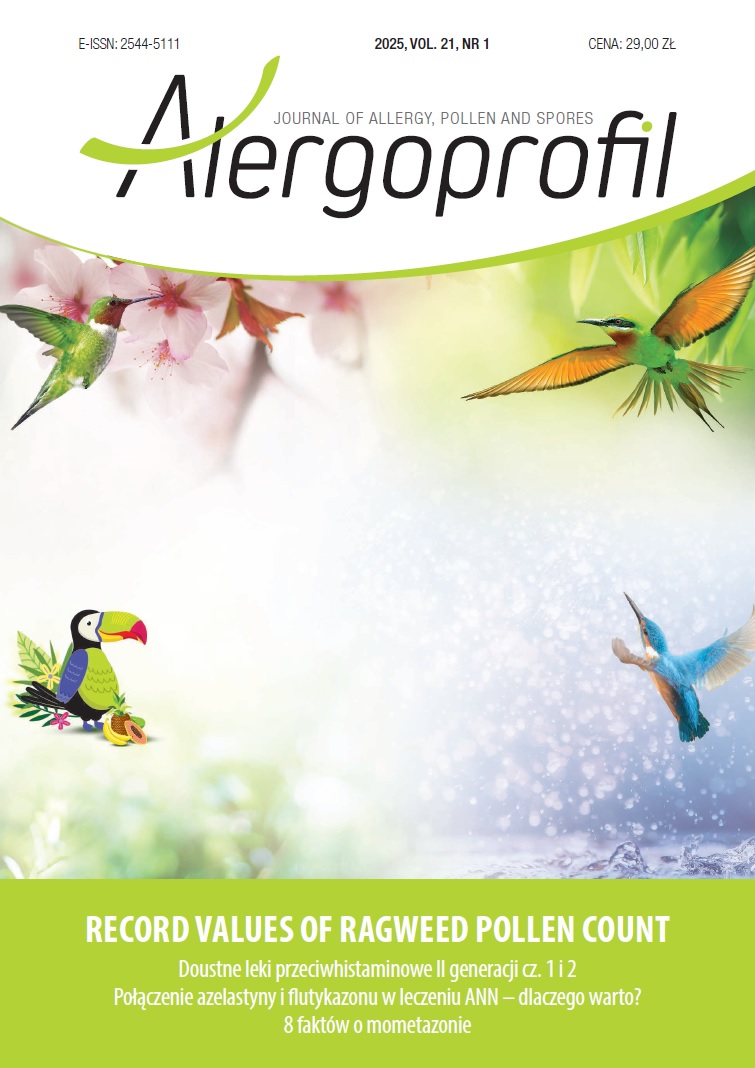Record values of ragweed pollen count in Poland in 2024 Artykuł oryginalny
##plugins.themes.bootstrap3.article.main##
Abstrakt
This paper presents the course of the pollen season of ragweed (Ambrosia) in selected cities of Poland (Lublin, Warsaw, Szczecin, Zielona Gora, Wroclaw and Bialystok) in 2024. The ragweed pollen grains are known as very potent aeroallergens, often noted to enter into cross reactions. This pollen is a common cause of pollinosis in North America. In Europe ragweed is an introduced species in the middle of an ongoing invasion event and, therefore, represents a case of a human population being exposed to increasing concentrations of this allergen.
Measurements were performed by the volumetric method (Burkard and Lanzoni pollen samplers). Pollen season was defined as the period in which 98% of the annual total catch occurred. Seasonal Pollen Index (SPI) was estimated as the annual sum of daily average pollen concentrations. The pollen season of Ambrosia in 2024 started first in Wroclaw, on the 12th of August, then in Lublin and Warsaw, on the 15th and 16th of August (about 1–2 weeks earlier than in the other cities). This pollen season lasted between the 22nd of September and the 27th of September. The differences of pollen seasons durations were clear (from 27 to 44 days). The highest airborne concentration of 174 pollen grains/m3 was noted in Lublin on the 4th of September. The maximum values of seasonal pollen count occurred between 4th and 17th of September, only in Wrocław 28th of August. The highest ragweed pollen allergen hazard occurred in 2024 in Warsaw and lasted 23 days and in Lublin – 22 days and was high. So far, in various years in Poland, this threat lasted less than 10 days.
Pobrania
##plugins.themes.bootstrap3.article.details##

Utwór dostępny jest na licencji Creative Commons Uznanie autorstwa – Użycie niekomercyjne 4.0 Międzynarodowe.
Copyright: © Medical Education sp. z o.o. This is an Open Access article distributed under the terms of the Attribution-NonCommercial 4.0 International (CC BY-NC 4.0). License (https://creativecommons.org/licenses/by-nc/4.0/), allowing third parties to copy and redistribute the material in any medium or format and to remix, transform, and build upon the material, provided the original work is properly cited and states its license.
Address reprint requests to: Medical Education, Marcin Kuźma (marcin.kuzma@mededu.pl)
Bibliografia
2. Mandrioli P, Cecco M, Andina G. Ragweed pollen: The aeroallergen is spreading in Italy. Aerobiologia. 1998; 14: 13-20.
3. Yankowa R, Baltadjieva D, Peneva R et al. Pollen grains of Ambrosia in the air of Sofia, Bulgaria. Aerobiologia. 1996; 12: 273-7.
4. Jäger S, Litschauer R, Ragweed (Ambrosia) in Austria. In: Ragweed in Europe. 6th International Congress on Aerobiology, 1998, Perugia, Italy.
5. Járai-Kamlódi M. Some details about ragweed airborne pollen in Hungary. Aerobiologia. 2000; 16: 291-4.
6. Tutin TG, Heywood VH, Burges NA et al. Flora Europea. Cambridge University Press, Cambridge 1986: 142-143.
7. Burbach GJ, Heinzerling LM, Rohnelt C et al. Ragweed sensitization in Europe – GA(2)LEN study suggests increasing prevalence. Allergy. 2009; 64; 664-5. https://doi.org/10.1111/j.1398-9995.2009.01975.x.
8. Hirschwehr R, Heppner C, Spitzauer S et al. Identification of common allergenic structures in mugwort and ragweed. J Allergy Clin Immunol. 1998; 101: 196-206.
9. Alcazar P, Comtois P. The influence of sampler height and orientation on airborne Ambrosia pollen counts in Montreal. Grana. 1999; 39: 303-7.
10. Nilsson S, Persson S. Tree pollen spectra in the Stockholm region (Sweden) 1973-1980. Grana. 1991; 20: 179-82.
11. Laaidi K, Laaidi M. Airborne pollen of Ambrosia in Burgundy (France) 1996-1997. Aerobiologia. 1999; 15: 65-9.
12. Smith M, Skjøth CA, Myszkowska D et al. Long-range transport of Ambrosiapollen to Poland. Agric For Meteorol. 2008; 148: 1402-11. https://doi.org/10.1016/j.agrformet.2008.04.005.
13. Bilińska D, Skjøth CA, Werner M et al. Source regions of ragweed pollen arriving in south-western Poland and the influence of meteorological data on the HYSPLIT model results. Aerobiologia. 2017; 33: 315-26. https://doi.org/10.1007/s10453-017-9471-9.
14. Puc M. Ragweed and mugwort pollen in Szczecin, Poland. Aerobiologia. 2006; 22: 67-78.
15. Weryszko-Chmielewska E (Ed.). Pyłek roślin w aeroplanktonie różnych regionów Polski. Kat. i Zakład Farmakognozji Wydz. Farmaceutycznego Akad Med, Lublin 2006.
16. Puc M, Kotrych D, Rapiejko P et al. Ragweed pollen season in the cities of northern Poland in 2016. Alergoprofil. 2016; 12(4): 178-81.
17. Piotrowska-Weryszko K, Weryszko-Chmielewska E, Lipiec A et al. Ragweed pollen season in southern Poland in 2016. Alergoprofil. 2016; 12(4): 182-5.
18. Weryszko-Chmielewska E, Woźniak A, Piotrowska-Weryszko K et al. Ambrosia pollen season in selected cities in Poland in 2018. Alergoprofil. 2018; 14(4): 111-6. https://doi.org/10.24292/01.AP.144311218.
19. Sulborska A, Weryszko-Chmielewska E, Rapiejko P et al. Allergenic Ambrosia pollen grains in the air of some Polish cities in 2019. Alergoprofil. 2019; 15(4): 10-6. https://doi.org/10.24292/01.AP.154251119.
20. Zhao F, Elkelish A, Durner J. Common ragweed (Ambrosia artemisiifolia L.): allergenicity and molecular characterization of pollen after plant exposure to elevated NO2. Plant Cell Environ. 2016; 39: 147-64. https://doi.org/10.1111/pce.12601.
21. Hamaoui-Laguel L, Vautard R, Liu L et al. Effects on climate change and seed dispersal on airborne ragweed pollen loads in Europe. Nature Climate Change. 2015; 5: 766–71. https://doi.org/10.1038/nclimate2652.
22. Lato 2024 w Polsce – charakterystyka wybranych elementów klimatu .

